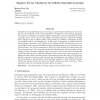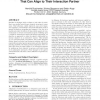147 search results - page 28 / 30 » Similarity of fuzzy choice functions |
JMLR
2008
13 years 5 months ago
2008
Ensemble learning algorithms such as boosting can achieve better performance by averaging over the predictions of some base hypotheses. Nevertheless, most existing algorithms are ...
AI
2002
Springer
13 years 5 months ago
2002
Springer
Research on resource-bounded agents has established that rational agents need to be able to revise their commitments in light of new opportunities. In the context of collaborative...
INFOCOM
2005
IEEE
13 years 11 months ago
2005
IEEE
—IP-Lookup is a challenging problem because of the increasing routing table sizes, increased traffic, and higher speed links. These characteristics lead to the prevalence of hard...
ATAL
2010
Springer
13 years 6 months ago
2010
Springer
Speakers in dialogue tend to adapt to each other by starting to use similar lexical items, syntactic structures, or gestures. This behaviour, called alignment, may serve important...
ISBI
2008
IEEE
14 years 6 months ago
2008
IEEE
We study the influence of the choice of template in tensorbased morphometry. Using 3D brain MR images from 10 monozygotic twin pairs, we defined a tensor-based distance in the log...


